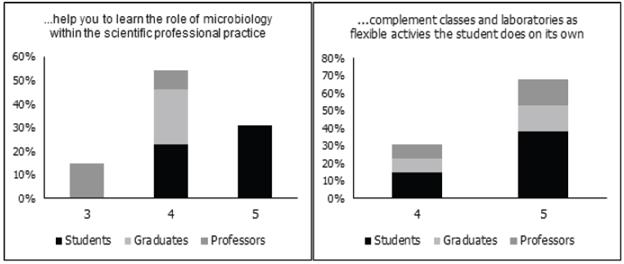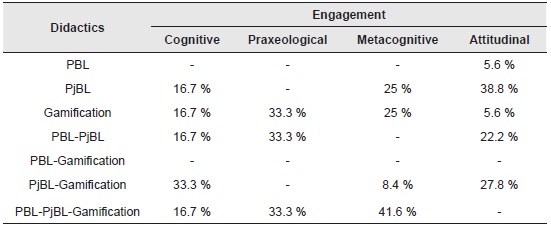1. Introduction
The COVID-19 pandemic is considered a challenge to higher education by limiting face-to-face activities (Mahase. 2020; Umaña-Mata. 2020), as well as affecting the emotional dimension of students and teachers, in the face of the stressful situation that the global state of emergency generated in relation to their economic. social. and health issues (Alcántara. 2020; Diez and Gajardo. 2020). In this context. education has provided the intellectual tools to adapt to environmental transformations (Cóndor-Herrera. 2020). However. traditional teaching methods such as lectures and master classes are less effective in improving the learning process of students because they are teacher-centered (Mohan. Nambiar and Arvindakshan. 2018). In science subjects such as microbiology, this problem means that the actual scientific processes are underrepresented in the textbooks. resulting in an inadequate understanding of the subject by students. who do not feel very engaged overall (Bowling. Klisch. Wang and Beier. 2013; Sillaots. 2014; Upadyaya et al.. 2021; Varannai. Sasvari and Urbanovics. 2017).
Hence. it is fundamental to rethink the conventional teaching didactics and design innovative materials to meet the pandemic demands in a blended and online teaching scenario. especially in biological science programs (Garcia-Penalvo. Corell. Abella and Grande. 2020; Umaña-Mata. 2020). In experimental disciplines such as microbiology. the acquisition of technical skills and metacognitive analysis is an uneasy task as it requires the cultivation and the study of microorganisms. equipment. and infrastructure for experimentation. as well as individual feedback on methods and interpretation of results (Dustman. King-Keller and Marquez. 2021; Sancho et al.. 2006).Thus. the current situation is ideal for transforming traditional teaching didactics or combining them with new alternatives that promote intentional, reflective, conscious, and self-regulated learning. associating the affective and cognitive aspects of the student (Diez and Gajardo. 2020).
In this sense. there is a need for learner-centered didactics that provide students not only with knowledge. but also with skills. values. autonomy. commitment. and creativity for their personal and professional future (Alcántara. 2020). Several didactics offer the mentioned aspects. For example. problem-based and project-based studies connect master classes information with laboratory skills (Drace. 2013; Seibert. 2021). A more recent trend in pedagogy involves using games that increase student engagement by applying newly developed knowledge and skills through challenge simulations. thus focusing attention on a particular topic and acquiring knowledge thanks to its playful nature (Drace. 2013; losup and Epema. 2014; Saleem. Noori and Ozdamli. 2021).The use of games in education along with a developed strategy is called gamification, and it can improve the learning process while increasing engagement and the sense of satisfaction (Sillaots. 2014; Upadyaya et al.. 2021;Varannai et al.. 2017).
These approaches address many of the limitations of traditional teaching. Although. the engaging experience of learning while playing games can contribute to the cognitive. praxeological. metacognitive. and motivational aspects (Deif. 2017) because fun and entertainment usually attract students. In addition, gamification through the use of ICT offers many advantages: use at any time and place. easy uploading and accessing to material. inclusion of multiple media (text. audio. graphics. video. and animation). and easy monitoring of students' progress (Masiello. Ramberg. and Lonka. 2005; Saleem et al.. 2021 ).Therefore, this research analyzed the impact of gamification on biology undergraduates in the Microbiology virtual classroom during the COVID-19 pandemic, to apply didactics in this branch and implement gamification in higher education.
This paper is structured as follows. In section two -the theoretical framework- the concept of gamification, its connection to the learning process. and current status in higher education are introduced. In the third section the methodological approach, including participants, development, implementation, evaluation of the didactics, (with emphasis on gamification) and the statistical analysis are described. In the fourth section the results are comprised, while in the fifth part, the authors' discussion on those results, previous studies, and the overview of the impact that gamification had on participants. Section six summarizes the principal findings of the study.
2. Theoretical framework
In early 2020. Wuhan. one of the most populous cities in China. was hit by a novel contagious disease called COVID-19. Since its outbreak. COVID-19 has wreaked havoc worldwide; several countries on all continents have been hit hard by severe COVID-19 outbreaks. The local spread became a public health crisis. and. eventually. on March 11. the World Health Organization -WHO- declared COVID-19 as a pandemic (WHO. 2020).This one has had a significant impact on all human activities. The actual magnitude of the pandemic remains unknown due to uncertainties in the spread of the disease. its severity and mortality rate. appropriate policy responses. and individual behavior (Ramelli and Wagner. 2020).The scenario led to rethinking teaching at all educational levels because educational institutions had to maintain their activities during the pandemic, exploring the virtual classroom and blending teaching and gamification.
Since the early 2000s, games were adopted in other contexts and defined as gamification (Iosup and Epema. 2014; Upadyaya et al.. 2021 ). It has become especially relevant in the XXI century because of its relationship with ICT (Luo. 2022; Sillaots. 2014). Gamification introduced dynamics, structures, designs, and game mechanics into non-gaming environments to enhance motivation. concentration. effort. and other positive values (Deterding. Dixon. Khaled and Nacke. 2011; Kalogiannakis. Papadakis and Zourmpakis. 2021). A gamified learning environment implements games in the education field as a supportive tool that engages students, ensures a meaningful and successful learning process, and promotes the development of associative thinking and problem-solving skills (Deterding et al.. 2011; Oliva. 2016; Saleem et al.. 2021; Yildirim. 2017). Several researchers have shown that gamification enriches the teaching-learning process by appealing to students' experience. sensations. and feelings (Lozada-Ávila and Betancur-Gómez. 2017; Sandrone and Carlson. 2021; Zichermann and Cunningham. 2011).
Much literature has been published regarding gamification in primary and secondary education; however, research in higher education is still scarce (Kalogiannakis et al.. 2021; Manzano-León et al.. 2021 ; Wiggins. 2016). Meanwhile. traditional methods in higher education have been considered non-motivational and discouraging when reinforcing learning. On the other hand, properly applied gamification didactics can improve student engagement, critical thinking development, attention. and meaningful learning (Oliva. 2016; Sandrone and Carlson. 2021). Next, examples of the use of gamification in higher education are mentioned. In Europe, gamification has been used with undergraduate students of medicine, engineering, social sciences, and informatics, providing flexible thinking to achieve deeper learning and understanding of class contents. resulting in higher grades. participation. and overall satisfaction of the students (Ebner and Holzinger. 2007; Iosup and Epema. 2014; Saleem et al.. 2021). In the United States, gamification was used in science education as a complementary tool. which. along with traditional didactics. improved teamwork skills. engagement to science. concept understanding. and research abilities (Bonde et al.. 2014; Jantakun and Jantakoon. 2021 ). In Colombia, the gamification didactics has been applied to university programs such as medicine. law. engineering. nursing. and political sciences. providing further evidence that it can indeed enhance student engagement (Corchuelo-Rodríguez. 2018).
Currently. educational computer games are used in multiple areas. although few are focused on topics related to biological sciences (Armbruster. Patel. Johnson and Weiss. 2009; Drace. 2013; Molnar. 2018), despite the benefits in terms of acquisition of cognitive elements and affective development (Bonde et al.. 2014; Jantakun and Jantakoon. 2021). Studies have shown that gamification increases engagement through immersion in fantasy, challenge, and competition, improving the assimilation of advanced concepts and procedures, especially in complex issues such as those related to the scientific practice (Manzano-León et al.. 2021 ; Nilsson and Svingby. 2009; Squire and Jan. 2007). In addition. the stimulating environment of the game allows the student to create action and decision strategies at different levels of difficulty, which could help develop problem-solving and decision-making strategies in the future. However. the implementation of this didactical approach can be challenging for educators due to the lack of practice in game interfaces and for students. to the connectivity. ICT limitations. and time management (Brom. Preuss. and Klement. 2011; Luo. 2022; Sisler and Brom. 2008).
3. Methodology
3.1. Participants
All participants in this research cooperated voluntarily and gave their informed consent according to the standards of the Bioethics Committee of the Universidad de los Llanos (Colombia).
The focus group consisted of students enrolled in a microbiology course of the Biology program (usually. ten semesters over five years) of the Universidad de los Llanos -a public institution- in the first academic semester of 2020 (July-November). Six students attended the sessions for the first time, 67 % male and 33 % female, from the 7th (67 %) and 8th (33 %) semester. The course lasted 17 weeks, and was developed blending modalities in 16 online master classes, including lectures and discussions with specialists. and four in person laboratory practices to teach basic techniques and methods following the anti-COVID-19 pandemic measures. For these students, this was the first participation in a blended or online course. One of the focus group's students stayed under the online teaching modality because he lived in a rural area and had difficulty accessing the university. Therefore, he did not participate in the four laboratory practices but in the other activities. He was still considered a member of the focus group because his performance throughout the course. and subsequent results were similar to those of the other students. That is. he was not affected by the distance learning modality. The other students lived in an urban area and had no difficulties attending the University. Three groups of individuals randomly selected were analyzed as comparison groups:
A group consisting of five professors who participated in the gamification pilot (Gl); 80 % female and 20 % male; 40 % from public universities and 60 % private. All of them belong to the natural, health and environmental sciences.
A group of 20 students from an external university who participated in the gamification pilot test (G2); 55 % male and 45 % female. All of them from a private university, in the 5th semester of an environmental science program.
A group of 13 participants: students (7). graduates (3). and professors (3) from different academic programs (natural. agricultural, environmental, and others) and universities (69 % public and 31 % private) who expressed their perceptions about the didactics of gamification (G3).
3.2. Development and implementation of the didactics
The implemented didactics were: Problem-Based Learning (PBL), Project-Based Learning (PjBL), and gamification; each combining theoretical and practical aspects to improve the engagement of the students in the microbiology learning process.
For the PBL and PjBL didactics. two methodological guides were prepared with audiovisual support (wikis. eBooks. videos) regarding the following:
Four experiments based on PBL. in which the students had to isolate and cultivate different microorganisms to answer three questions (What microorganisms are involved in the decomposition of papaya and the fermentation of pineapple? Are there anaerobic bacteria in soil? How to obtain strains of edible macrofungi?).
Assembly and analysis of a mesocosm as a PjBL activity.
The students proceeded in their homes -observing through a home-made microscope- and in the face-to-face laboratories. They were monitored throughout the process. Finally, the students submitted their findings in one presentation on PBL didactics and three on PjBL didactics.
The gamification of learning in this research was developed using ICT tools. The pilot game design operated on two open-access web-based platforms. Genially (https://www.genial.ly/es) and Classcraft (https://www.classcraft.com/es) (Table 1). The game topic read "Washing and sterilizing methods". and the focus group. Gl professors. and their students (G2) played it. A 21-item semi-structured online questionnaire (Ql) was applied to them via Google Forms; there. the participants rated each of the following four aspects on a scale of l to 5 (5 being the highest): i.) cognitive-praxeological competence; ii.) level of interest; iii.) ease of use; iv.) game difficulty. They also indicated their preference for one of the two platforms in relation to aspect and rated each aspect individually. Ql details are specified in Table 2 and section 3.4. From the results (Table 3), it can be observed that the interviewed chose the Genially platform for better development of gamification didactics. In addition, following the professors, changes were made, such as adding questions based on hypothetical scientific cases. including a metacognitive feature in the games.
As established in the microbiology curriculum and laboratory practices, five games were developed (Table 1) containing levels of difficulty, and each level had: i.) Instructions; ii.) The historical narratives of microbiology and impact on human life as an introduction/contextualization; iii.) multimedia tutorials with concepts and laboratory procedures (original material. designed. recorded. and edited by the authors). a total of 20 multimedia tutorials with a 5 minutes average duration each; iv.) multiple choice exercises with immediate feedback exploring different stages of the cognitive-praxeological learning such as theoretical principle. description of real laboratory cases. execution of methods. and results analysis. The exercises were presented in four modalities: "quiz", "search", "correct image" and "series". The first two consisted of answering a question or problem. In "correct image", the players had to interpret and analyze images (test results, diagnostic morphological features, etc.) to identify microorganisms and the correct use of laboratory instruments. In "series", the participants were required to select and order the steps of a laboratory process. Upon completion of each level, players were given a number to complete a unique code (different for each participant) to complete the game.
The pilot test was conducted during a two-hour online session to explain how to use the platforms, supervise participants as they played, and address their concerns. Students played the following five games on their own, with autonomous time management but with a deadline for each one. The reward received after completing the games was a 5.0/5.0 in one of the course grades. In addition, students' interaction with the platform was monitored through video views and time spent playing the games.
3.3. Evaluation of the didactics
After implementing and conducting gamification didactics along with PBL and PjBL, an online structured questionnaire (Q2) from Google Forms was used to evaluate the engagement of the focus group. Q2 had 12 items and asked which didactic or combination of didactics enhanced the engagement of the participants according to the following aspects: i.) Cognitive competence; ii.) Praxeological competence; iii.) Metacognitive competence; iv.) Attitudinal component. Finally, students were invited to respond to a 5-point Likert scale (1-strongly disagree, 2-disagree, 3-neutral, 4-agree, and 5-strongly agree), to statements related to their engagement in the microbiology classroom (Joshi, Kale, Chandel and Pal, 2015).
Another online structured questionnaire (Q3) from Google Forms with 21 items was completed by the G3, in which they rated on a scale of 1 to 5 (5 being the highest score) the audiovisual quality and contribution to the different learning competencies of gamification, after playing the six games (Table 1). Participants also indicated how interested they were in the subject of microbiology using a 5-point Likert scale (Joshi et a!.. 2015). Both questionnaires are described in Table 2.
3.4. Statistical analysis
The information was analyzed with a comparative-descriptive approach to identify significant differences in the mean values for each category of questions related to gender, type of university (public/private), type of participant and others. Excel and SPSS 19.0 were used for this purpose, and the Mann-Whitney and Kruskall-Wallis nonparametric tests (Dexter, 2013; Sawilowsky and Fahoome, 2014). Tukey's HSD was employed with a significance level of P=0.05 (Table 3).
4. Results
4.1. Gamification pilot test
In order to choose one of the online gamification platforms, a pilot test was carried out with the focus group, Gl professors and their students (G2). After contemplating the four aspects of the questionnaire (Ql), 100% of the focus group showed a preference for Genially, as well as 60% of the professors and 80% of the external students. The numerical assessment (1-5) privileged Genially in the "cognitive-praxeological competence", "level of interest" and "ease of use" categories (Table 3). Genially's main advantage over Classcraft was exhibited in the "level of interest", where its evaluation was significantly different in the G2 (P=0.0046, Mann-Whitney test), and in the "ease of use", finding significant differences in the focal group (P=0.004, Mann-Whitney test) and in the G2 (P=0.0006, Mann-Whitney test). Regarding the negative aspect "Game difficulty", Classcraft obtained a higher score (Table 3), mainly associated with understanding the platform interface and following instructions.
Table 3 Results of the gamification pilot test. Preference is expressed as a percentage. Mean score is on a scale of 1-5, with standard deviation value (±)
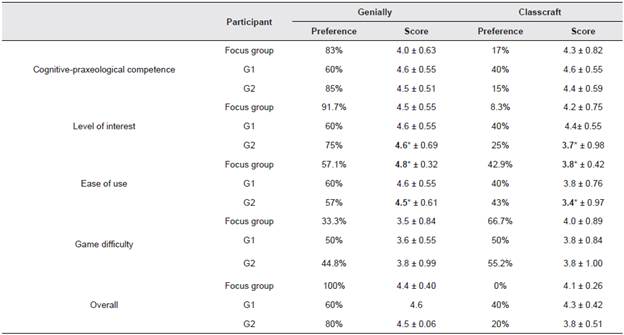
Values in bold and * represent significant differences between Genially and Classcraft for that one aspect and group (Mann-Whitney test, P-0.05).
Source: This study
4.2. Effect of gamification, PBL and PjBL didactics
In order to determine the effect of gamification applied to the microbiology virtual classroom in undergraduate Biology students during the COVID-19 pandemic, the answers from the focus group regarding the engagement derived from gamification, PBL and PjBL didactics (Q2), and measured according to the cognitive, praxeological, metacognitive and attitudinal component was considered, as the answers of the external public (Q3).
As stated by the focus group, Figure 1 and Table 5 (Annexes) show the most influential didactics or combination of didactics on student engagement. Cognitive reinforcement was attributed to gamification 66.7% of the time (gamification 16.7%, PjBL-gamification 33.3%, PBL-PjBL-gamification 16.7%). In terms of praxeological skills, the benefits were perceived to be the same for all three didactics (66.6%). Students also identified that gamification (75%) and PjBL (75%) improved their metacognitive learning. Finally, gamification was rated as the second didactics that positively influenced their attitude toward studying microbiology. It is noteworthy that in most cases, the focus group considered that combining two or three didactics allowed for a more comprehensive engagement and thus facilitated the development of each component. However, gamification stood out as the only didactic approach that by itself had a positive effect on all four engagement components.
Similarly, the external participants (G3), composed of students, graduates, and professors from eight different higher education institutions, valued the audiovisual quality of the multimedia tutorials and games used in gamification, as well as the engagement that resulted from the games (Q3, Table 4). Overall, the participants gave high scores (≥4) to the audiovisual aspects and content quality of the games as well as the contribution to the cognitive (≥4.2) and metacognitive (≥4) components. Significant differences were revealed by the general assessment among students (P=0.01, Kruskall-Wallis test), graduates (P=0.005, Kruskall-Wallis test), and professors (P=0.01, Kruskall-Wallis test). The latter group rated the effect of gamification on engagement and its contribution to microbiology learning more positively, followed by undergraduates and graduates (Figure 2).
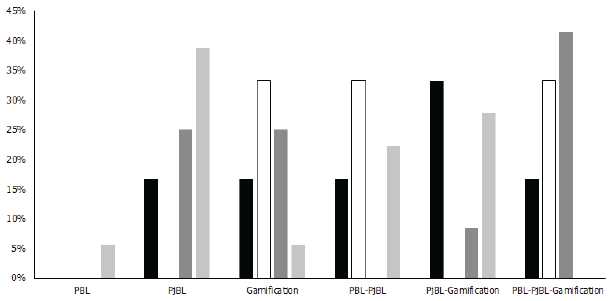
Source: This study
Figure 1 Effect of the gamification, PBL and PjBL didactics in the engagement and development of cognitive, praxeological, metacognitive and attitudinal components according to the focus group (G2).
Table 4 Results of the evaluation of audiovisual aspects and the effects of gamification according to the external participants (G3) in Q3. Mean score is based on a scale of 1-5, with standard deviation value (±)

Values in bold and a, b, c represent significant differences among institutional participants (Kruskall-Wallis test, P=0.05, Tukey’s HSD).
Source: This study
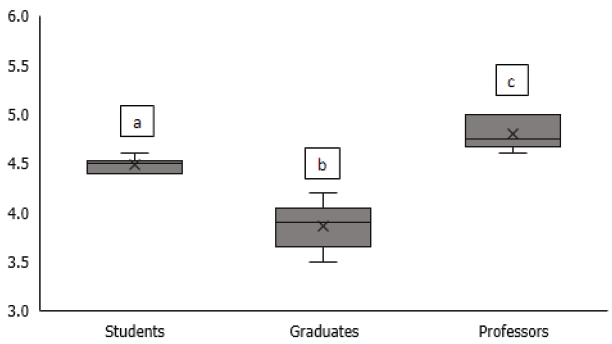
Source: This study.
Figure 2 Overall assessment of the gamification didactic according to the external participants: Students, graduates and professors (G3) in Q3.
The focus group felt that the three didactics implemented impacted positively its meaningful learning (Figure 3) on the Likert scale. The total of students marked 4 and 5 when referring to the reinforcement of knowledge and skills from the three didactics (Figure 3). Similarly, the G3 perceived gamification as engaging (70-77 % scores of 4 and 5) and functional when learning microbiology concepts, procedures, and interpreting results (Figure 4). The focus group agreed that gamification is indirectly related to the cognitive, praxeological, metacognitive, communicative, and attitudinal components, hence improving their engagement with Microbiology learning (Figure 5). Also, the group pointed out that gamification, together with PBL and PjBL, reinforces what is learned in class and the laboratory. Therefore, through the complementarity of teaching strategies a meaningful learning experience can be achieved. G3's perception of the complementarity provided by gamification supports these findings (Figure 6).
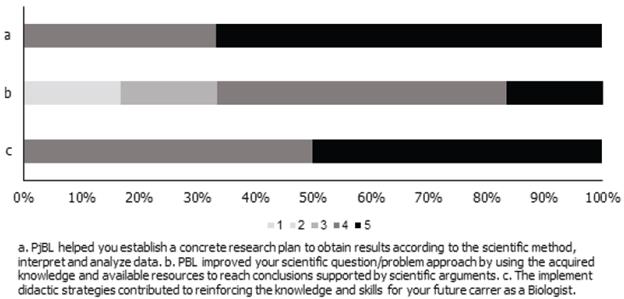
Source: This study.
Figure 3 Effect of the three didactics on meaningful learning according to the focus group in Q2.
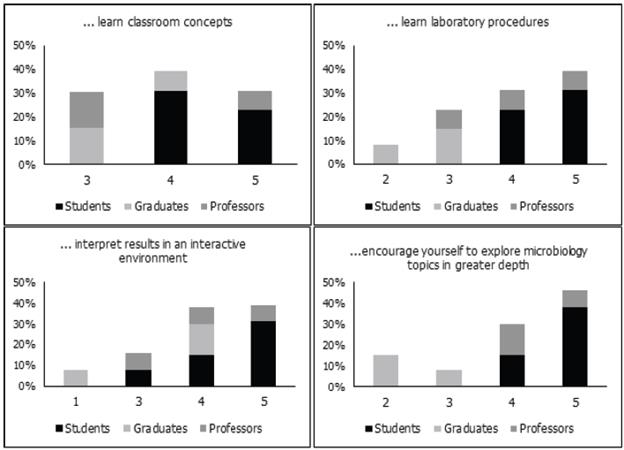
Source: This study.
Figure 4 Effect of gamification on meaningful learning according to the external participants (G3) in Q3. Each sentence read: "The games helped you to...".
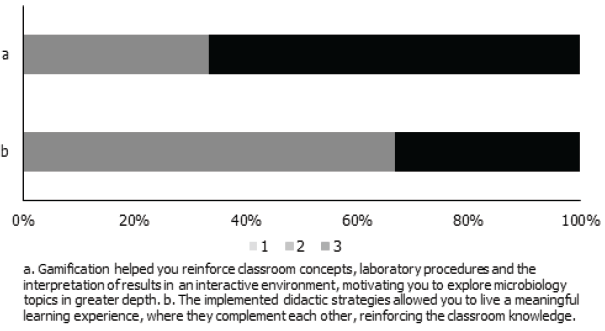
Source: This study
Figure 5 Effect of gamification and complementarity of didactics according to the focus group in Q2.
5. Discussion
The COVID-19 pandemic brought substantial challenges to higher education ranging from health risks, economic crisis, and job insecurity to difficulties in the learning environment (Alcántara, 2020; Cóndor-Herrera, 2020; Diez and Gajardo, 2020). For example, students have limitations to attend face-to-face laboratory practices and problems with time management because they have to take on household responsibilities or work to earn extra income during times of crisis. These concerns are shared by them, experiencing the effects of the COVID-19 pandemic (Garcia-Penalvo et al. 2020), and those who have online or ICT-mediated education for the first time (Hedayati-Mehdiabadi, Huang and Oh, 2020). Therefore, there is a potential for gamification didactics in the microbiology classroom, that can strengthen the attitudinal component of learning, affected by the state of anxiety and uncertainty derived from the COVID-19 pandemic (Diez and Gajardo, 2020; Mahase, 2020). It would support the development progress of praxeological skills in a context of limited access to laboratories (Drace, 2013; Dustman et aL.2021; Molnar, 2018). In this scenario, the present research selected three didactic strategies to enrich the Microbiology learning during the COVID-19 pandemic: PjBL, PBL (Anazifa and Djukri, 2017; Espino-Hernandez et aL 2011; Saalu, Abraham and Aina, 2010; Seibert, 2021) and gamification (Beylefeld and Struwig, 2007; Drace, 2013; Dustman et al. 2021; Mayer, Warmelink and Bekebrede, 2013), since they provided opportunities to develop various skills and students' engagement to achieve meaningful learning.
Gamification, as the core of this research, has been analyzed by different authors, finding that it significantly augments the engagement during the learning process, contributes to the acquisition of knowledge and boosts students' confidence (Beylefeld and Struwig, 2007; Brom et al.. 2011; Drace, 2013; Kalogiannakis et al.. 2021; Molnar, 2018). These effects are attributed to the dopaminergic reinforcement generated by game stimuli (Goethe, 2019; Mazzoglio y Nabar, Algieri and Tornese, 2018; Oliver, 2017), because students are constantly refining their abilities and potential (Drace, 2013; Yildirim, 2017; Zahedi et al. 2021), and have a personalized experience through rewards for hits or reinforcements for mistakes; two situations that participants faced in this research (section 4.2, Figure 1, Figure 3, Figure 5, Table 5).
Thus, games helped consolidate and integrate knowledge acquired in online theoretical classes and laboratory practices (Brom et al. 2011; Drace, 2013; Molnar, 2018), particularly when they included activities related to higher-order thinking skills (Anazifa and Djukri, 2017; Cea-Álvarez, 2015; Oliveira et al.. 2021; Saalu et al. 2010). Professors are aware of these benefits as during the gamification pilot test they recommended increasing the number of questions related to metacognitive analysis and interpretation of numeric and graphic experimental data, specifically related to real-life situations (section 3.2., section 4.1.). It is worth mentioning that many professors expressed their interest in the gamification didactic; however, they stated that the lack of institutional support hinders the implementation of new didactical activities, especially given the work overload caused by the COVID-19 pandemic (Aldossari and Chaudhry, 2021; Sokal, Trudel and Babb, 2020).
Furthermore, the user experience influences the effect of gamification on the learning process and can be affected by access to connectivity, familiarity with computer games, as well as game features (Brom et al. 2011; Schöbel, Janson and Söllner, 2020). There are three main components that make a game appealing: first, a dynamic that provides integrity and consistency and allows for the development of intrinsic motivation, which is composed of narrative technique, constraints, and emotions within the game (Jawad and Tout, 2021 ; Molnar, 2018; Oliver, 2017). Second, the defined mechanics of the structural elements in the game, such as challenges and competition (Goethe, 2019). Finally, the gratification, that is, what the player attains after achieving each goal, such as points, levels or rewards (Goethe, 2019;Yildirim, 2017). Consequently, the games developed in this research included a narrative context to explain the origin of the experimental knowledge addressed in each game, multimedia tutorials that illustrated laboratory procedures and interpretation of results, and a series of challenges or activities that tested students' memory and metacognitive analysis (section 3.2., Table 1). It was also identified that easiness when interacting with the gamification platform and the variety of activities were key features that increased students' interest and play experience, as demonstrated by the pilot test that compared the Genially and Classcraft platforms (section 4.1., Table 3). Previous research also highlighted that the students seek a dynamic, clearly structured and playful experience when interacting with the didactic tool (Ioannidou et al. 2010; Mese and Dursun, 2019; Toda et al.. 2019).
The evaluation on the effect of the implemented didactics underlined that the games had a positive influence on the learning process and that gamification can indeed upgrade student engagement in a blended and online Microbiology course, represented in the development of cognitive, metacognitive, praxeological and attitudinal skills (section 4.2., Figure 1, Figure 3, Figure 5,Table 5), as indicated by Rosenbaum, Klopfer and Perry (2007); Huizenga, Admiraal, Akkerman and Dam (2009); Huang (2011); Drace (2013), and Molnar (2018), despite the technical limitations experienced by some students that can lead to user frustration (Fithriani, 2021; Wrzesien and Alcaniz, 2010). The present gamification didactic was developed using ICTs tools so that all participants could have access to it, and the concerns of each student were carefully considered to monitor their development and group dynamics. Hence, since the student is involved in the decision-making part, a more assertive approach is achieved and the student becomes the center of the teaching-learning process (Obaya.Vargas. Giammatteo and Ruiz, 2019; Oh, Huang and Hedayati-Mehdiabadi, 2018).
Learning outcomes can be improved when gamification is used as part of a varied curriculum along with other didactics focused on the theoretical and experimental development of components of the microbiology course (Werbach, 2014; Yildirim, 2017), indicating in this sense that the implementation of complementary pedagogical units in the Microbiology course enriches the learning process and potentiates the engagement of the students while increasing their resilience to the circumstances of the current pandemic (de A. F. F. Finger et al.. 2020).
6. Conclusion
According to the results obtained in this research, the diversified didactics, including gamification, increase engagement and the development of cognitive, metacognitive, praxeological and attitudinal skills, while enhancing the Microbiology learning experience in Biology undergraduates. This effect was evident in students with unfavorable learning environments and those who could not be present during the experimental activities. They considered that gamification contributed enormously to their engagement in the learning process, increasing the interest in class activities even under the stressful circumstances created as a result of the COVID-19 pandemic. Case or problem analysis (PBL), semester project (PjBL), and gamification didactics showed correlative contributions to the development of different learning dimensions that encompass the requirements of addressing the diversity of ways of learning in students.
As for recommendations, on the one hand, it is suggested that gamification be included as means to energize the classroom activities and reinforce learning. On the other hand, given the complementarity of PBL and PjBL didactics to gamification and master classes, it is advisable to consider the availability of interests and resources among students in advance. This would facilitate participation in the practical exercises and the obtention of the expected results.
















